And the River Still Sings actually got home 5 days ago, but I hit the ground running. Two days to unpack and sort (I still have not found everything I tidied away before the dog-sitters arrived), a day to make bone broth and baking – gluten-free for me and wheat bread for a potluck event at the Tatla Hall on Saturday night, then there was the guest cabin to clean out – a packrat had got into the enclosed porch and made a glorious mess – the trap had to be reset and the mess cleaned up (I got the little b–), a trip to the post office and the rancher I buy meat from on Monday, and yesterday I drove 3 and half hours back into Williams Lake with my ailing truck to leave it for a $1400 job. I was met there by Sarah, the wonder-wwoofer made famous in Ginty’s Ghost, who is going to work some more of her magic over the next few days – she now is not only an excellent carpenter but also a fully qualified electrician! So I have plenty of excuses for not keeping this blog up to date.
After Summerland (see previous post) I spoke in Penticton, and the librarian kindly took me to her home in Ocean Falls to spend the night. Nearby was a piece of Nature Trust property, all too small and surrounded by development, but delightful to spend a bit of time on. (You could, of course, hear the traffic from Hwy 97 roaring in the valley.)
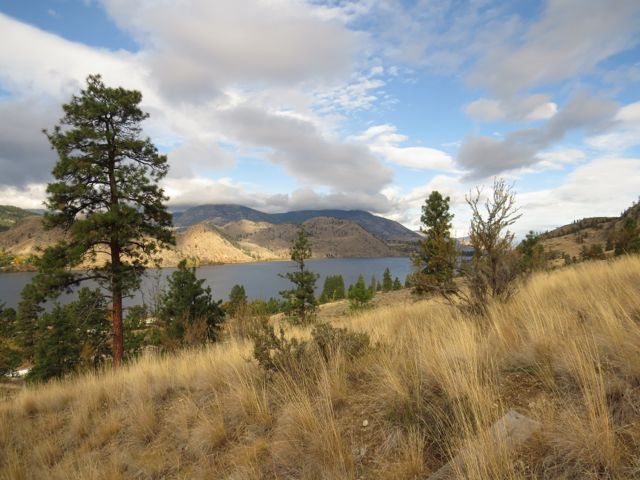
The dominant shrub was antelope bush, a straggly plant not found in the grasslands further north.
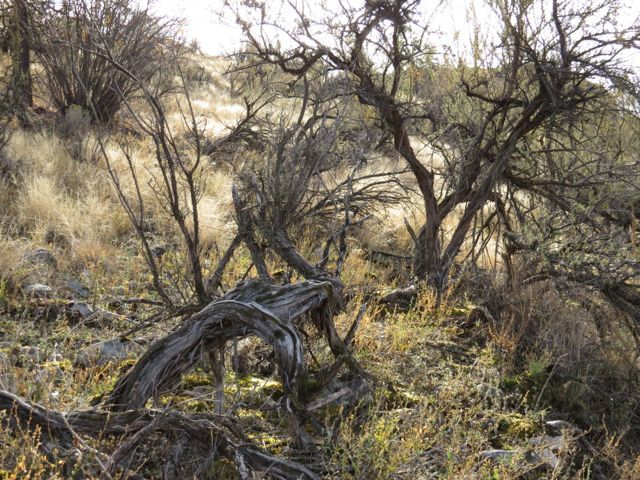 I also found a few faded brown-eyed susans.
I also found a few faded brown-eyed susans.
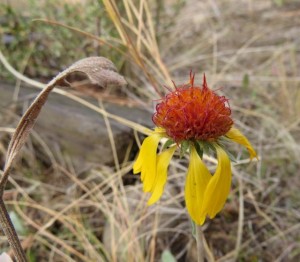 The many rock outcrops were simply covered in mosses and lichens. (The grey colour is all lichenous growth.)
The many rock outcrops were simply covered in mosses and lichens. (The grey colour is all lichenous growth.)
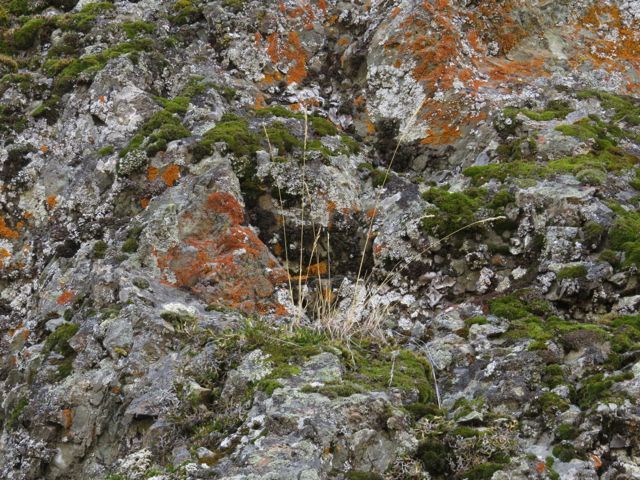 I even found a shrivelled cactus. This small relative of the Prickly Pear grows as far north as Tatla Lake.
I even found a shrivelled cactus. This small relative of the Prickly Pear grows as far north as Tatla Lake.
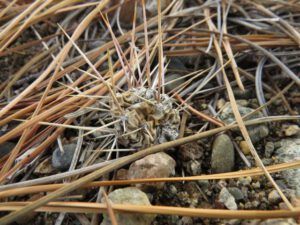
Then on to Osoyoos. I stopped for a break on a side road. I was intrigued by the great numbers of birds settling on the power lines.
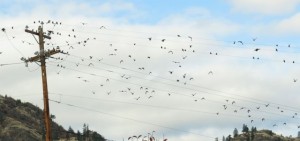 Which proved to be starlings. Gunshots from the automatic noise-makers sounded frequently in the vineyards close by.
Which proved to be starlings. Gunshots from the automatic noise-makers sounded frequently in the vineyards close by.
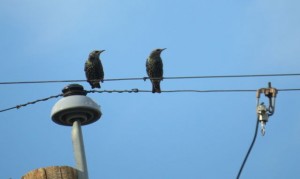
Osoyoos was as far south as I would go: indeed, I could not have gone further south without a passport because it was right on the US border. When my host (the librarian’s husband) volunteered to show my around, I was delighted, but puzzled when he said he’d take me to the border. We stopped just two small blocks above the official border crossing. Facing us was an old 2-strand barbed wire fence, which I very daringly stepped over!
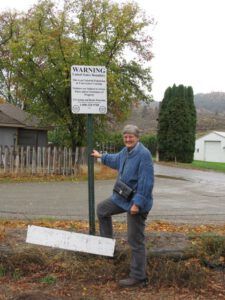 Here is the upper notice:
Here is the upper notice:
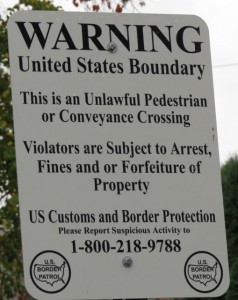 The lower one is illegible.
The lower one is illegible.
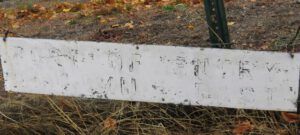 So much for the security-conscious Americans. Did they have cameras hidden in the orchards beyond the fence? A new fence (also 2 strands of barbed wire: it’s the one on the left) has been built up the hillside. To keep the dangerous Canadian terrorists from crossing illegally, no doubt.
So much for the security-conscious Americans. Did they have cameras hidden in the orchards beyond the fence? A new fence (also 2 strands of barbed wire: it’s the one on the left) has been built up the hillside. To keep the dangerous Canadian terrorists from crossing illegally, no doubt.
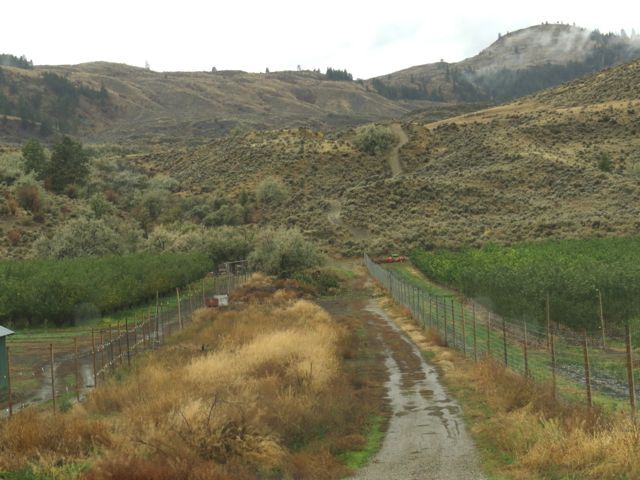
As you can see, In Osoyoos, it rained.
Another feature in the area is the famous Spotted Lake. Mineral deposits cause the rims around the circles. The local Indian band claim medicinal qualities to the mud and casual visitors are barred from getting close. (Note more development on the hills behind.)
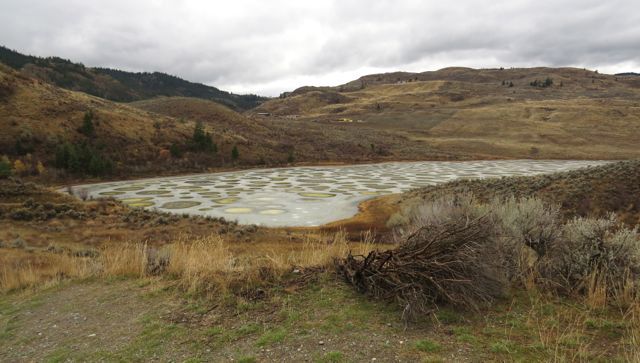
Next stop was Vernon. Still raining. I stayed with wonder-wwoofer Sarah’s parents, high above Vernon. Their yard was full of gorgeous larches. (Still raining.)
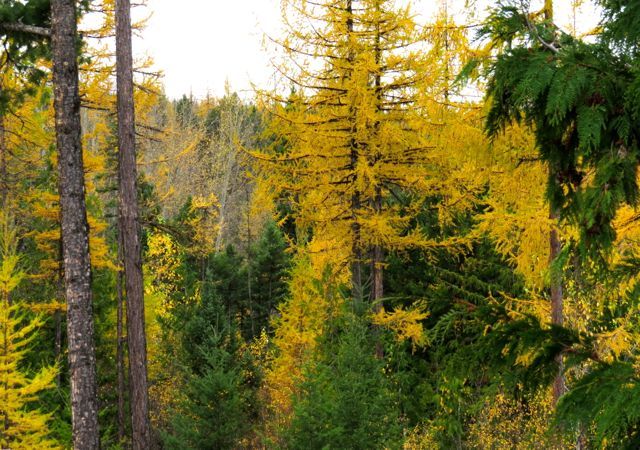
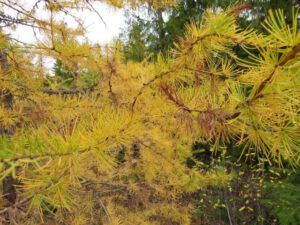 Then Revelstoke. Now I was really hitting the wet belt.
Then Revelstoke. Now I was really hitting the wet belt.
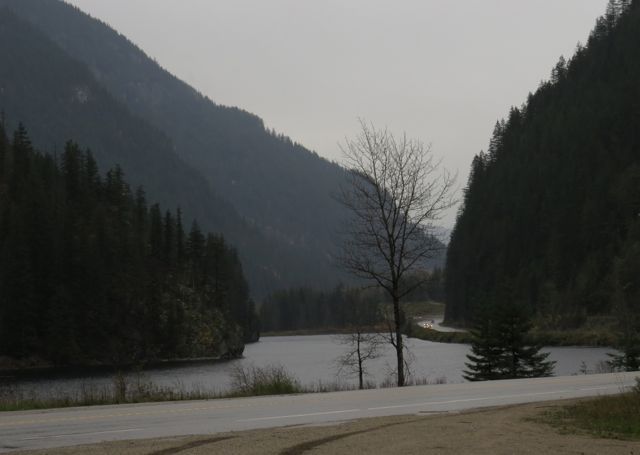 Revelstoke is an old railway town and base for the major dams across the Columbia River. If it wasn’t for the rain, I would like to live close by. The people are mountain lovers on the whole, and the old houses have mostly been attractively refurbished.
Revelstoke is an old railway town and base for the major dams across the Columbia River. If it wasn’t for the rain, I would like to live close by. The people are mountain lovers on the whole, and the old houses have mostly been attractively refurbished.
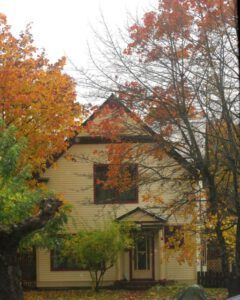
One yard housed this spectacular Japanese maple.
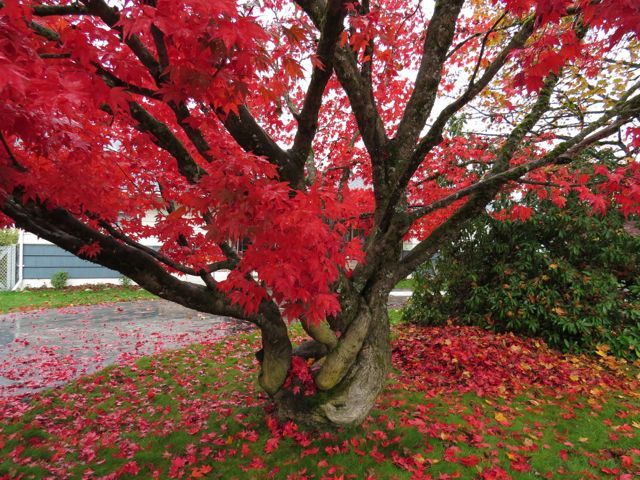 When I turned the vehicle back west from Revelstoke, I at last had the feeling I was heading home. Salmon Arm was next, however. I stayed with a friend who was my neighbour all those years ago when I lived in the little shack by the cedar tree (mentioned in And The River Still Sings.) The shack is still there!
When I turned the vehicle back west from Revelstoke, I at last had the feeling I was heading home. Salmon Arm was next, however. I stayed with a friend who was my neighbour all those years ago when I lived in the little shack by the cedar tree (mentioned in And The River Still Sings.) The shack is still there!
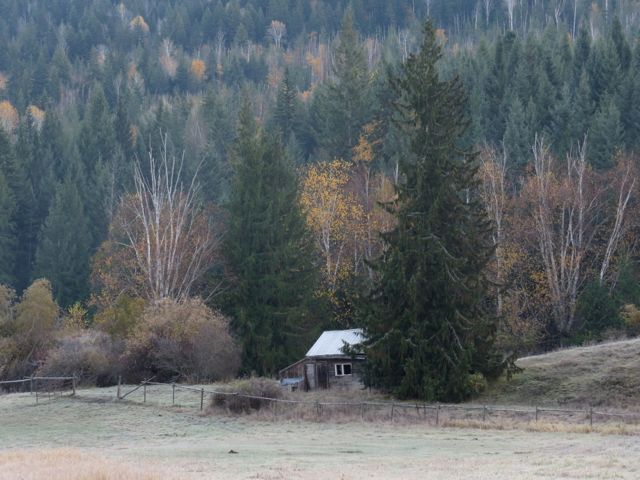 Gudie’s house is high on the hillside. She is a keen gardener.
Gudie’s house is high on the hillside. She is a keen gardener.
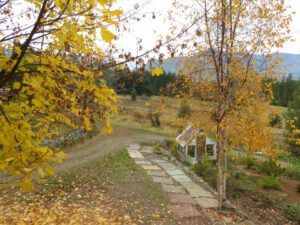 She is the only person I have ever met who has doilies on her deck!
She is the only person I have ever met who has doilies on her deck!
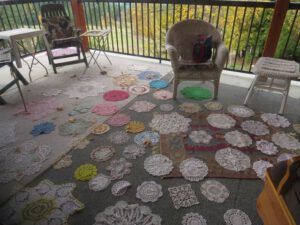 They are there because she is working on a craft project! Gudie is very creative. Many years ago, I taught her to spin and now she is an accomplished weaver, paper-maker, flower presser and so on. It will be interesting to see what she does with the doilies!
They are there because she is working on a craft project! Gudie is very creative. Many years ago, I taught her to spin and now she is an accomplished weaver, paper-maker, flower presser and so on. It will be interesting to see what she does with the doilies!
The morning I left there, the rain finally quit.
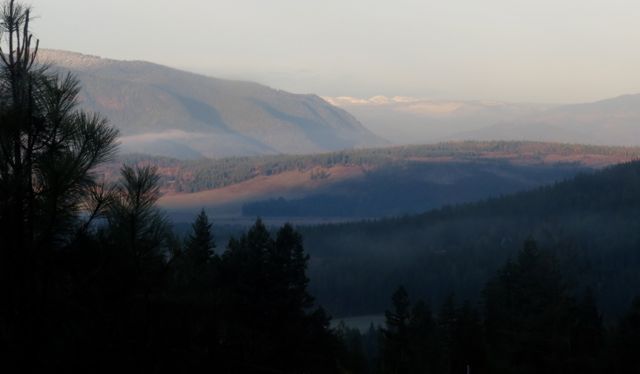 On the way north, I visited the Adams River salmon spawning site. What a difference from when I used to visit! Now there are tons of people – as is evident from the veritable village of outhouses!
On the way north, I visited the Adams River salmon spawning site. What a difference from when I used to visit! Now there are tons of people – as is evident from the veritable village of outhouses!

Attractive, easy trails meander through the forest.
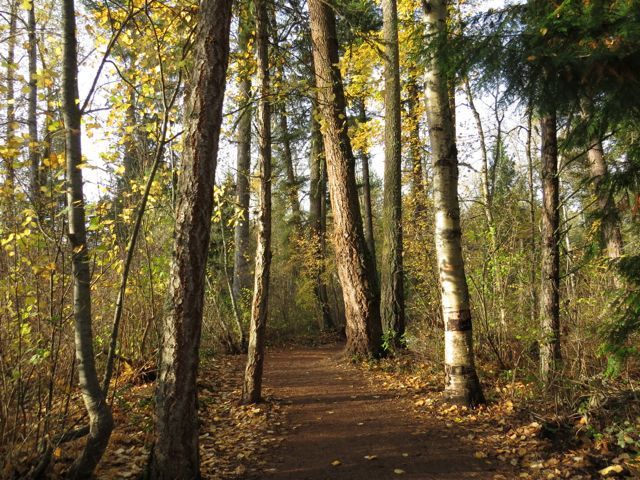 Here is a backwater so typical of this climate.
Here is a backwater so typical of this climate.
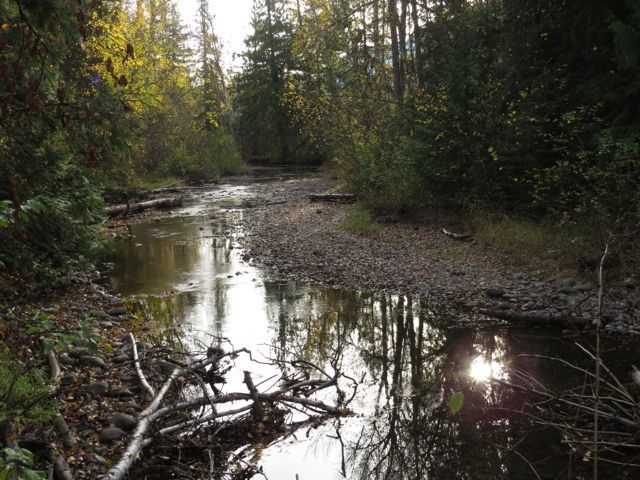 Along the river bank are a pair of curious cottonwoods.
Along the river bank are a pair of curious cottonwoods.
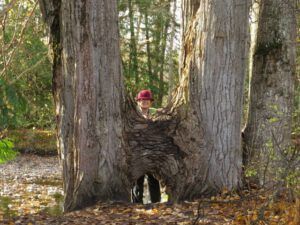 But the salmon is what we have come to see.
But the salmon is what we have come to see.
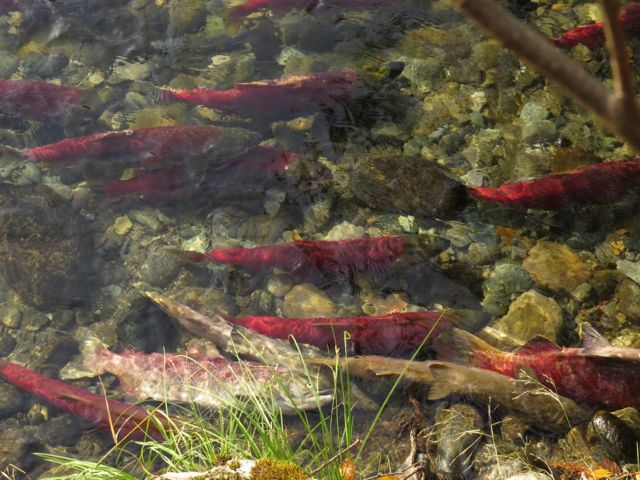 These are sockeye: when they come to spawn, their heads turn green and their bodies turn red. Unlike the Atlantic salmon, once they have bred, they die. The mould that covers the carcasses is thought to help feed the new hatchlings. The living fish swim constantly to maintain their places in the swift, shallow current. This is a sight that everyone should see in their lifetime. (It is very familiar to me – it happened at my first log cabin at Lonesome Lake – written about in Cabin At Singing River.)
These are sockeye: when they come to spawn, their heads turn green and their bodies turn red. Unlike the Atlantic salmon, once they have bred, they die. The mould that covers the carcasses is thought to help feed the new hatchlings. The living fish swim constantly to maintain their places in the swift, shallow current. This is a sight that everyone should see in their lifetime. (It is very familiar to me – it happened at my first log cabin at Lonesome Lake – written about in Cabin At Singing River.)
Here is a dead female – the upper jaw is relatively straight.
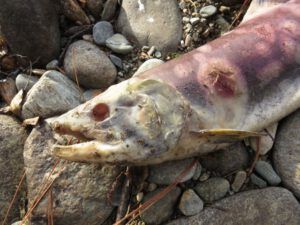 And a dead male – all ready for Halloween.
And a dead male – all ready for Halloween.
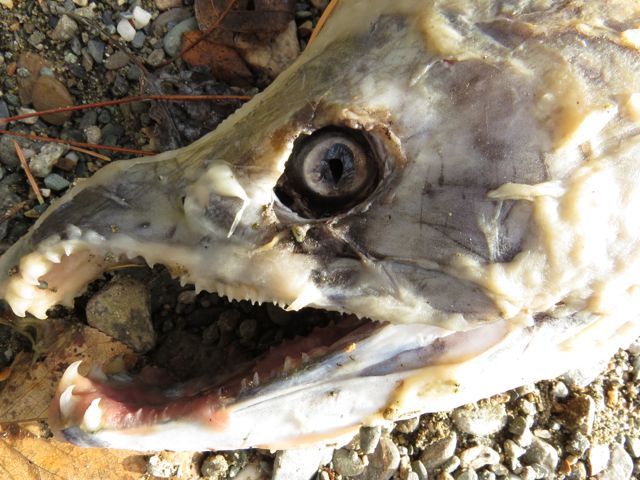 Other creatures were present in the river. A team of photographers were making a film to be projected onto the Cambie Bridge in Vancouver during the fireworks display.
Other creatures were present in the river. A team of photographers were making a film to be projected onto the Cambie Bridge in Vancouver during the fireworks display.
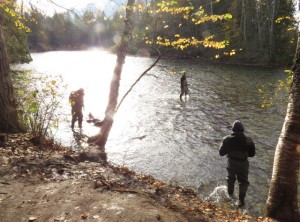 Many lay in the water to take pictures. All this disturbance of the salmon redds is not normally allowed. I wonder what the water tasted like….?
Many lay in the water to take pictures. All this disturbance of the salmon redds is not normally allowed. I wonder what the water tasted like….?
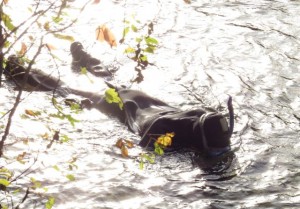 During the rains, it had snowed at higher elevation, and a sugaring still lay on the trees on the road between Little Fort and 100 Mile.
During the rains, it had snowed at higher elevation, and a sugaring still lay on the trees on the road between Little Fort and 100 Mile.
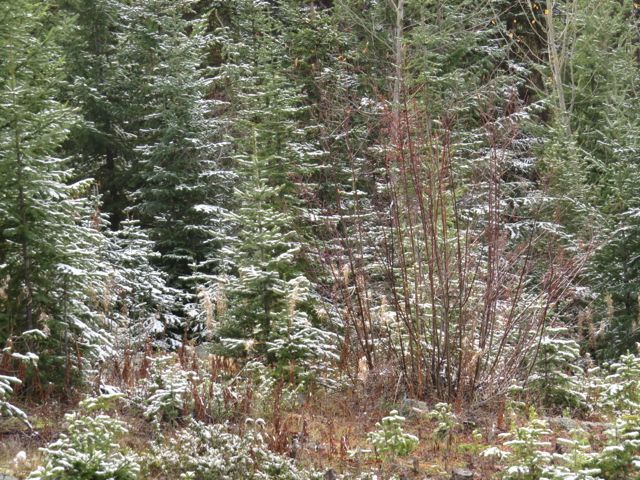
Two slide shows in 100 Mile and at last the final performance in Williams Lake. I could hardly believe that I was done. In nearly 5 weeks I had performed 26 times. Some last minute shopping and up I drove onto the Chilcotin.
No leaves left on the deciduous trees here. The the pond by the rest stop near the Eagle Lake Road was full of birds. About 60 trumpeter swans bobbed heads and honked and flapped wings, no doubt asserting dominance – why couldn’t they just move away from each other a bit?
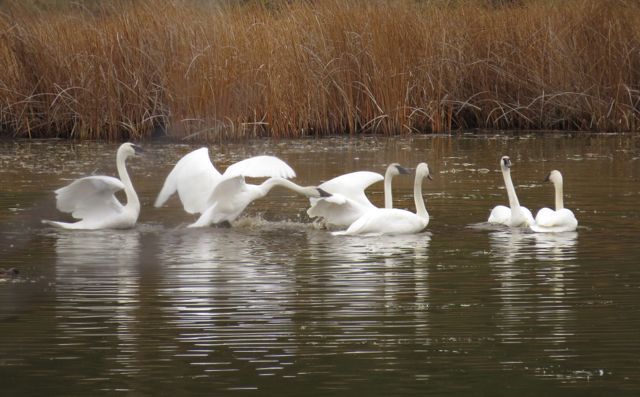 Swans have long necks so they can grub about in deeper water than that which most non-diving birds can reach. They always have an entourage of other feeders anxious to gobble up leavings.
Swans have long necks so they can grub about in deeper water than that which most non-diving birds can reach. They always have an entourage of other feeders anxious to gobble up leavings.
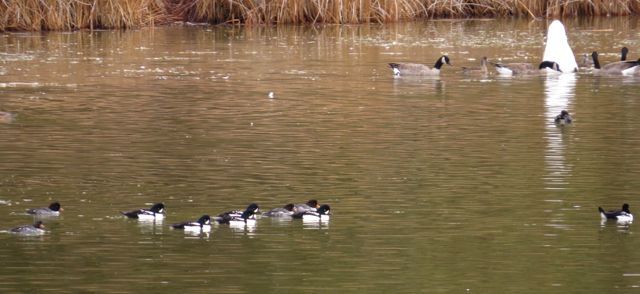 And at last, Nogwon. Somewhat grim and gloomy in this light, but my heart soars when I see this view because I know that I am only 20 minutes from home.
And at last, Nogwon. Somewhat grim and gloomy in this light, but my heart soars when I see this view because I know that I am only 20 minutes from home.
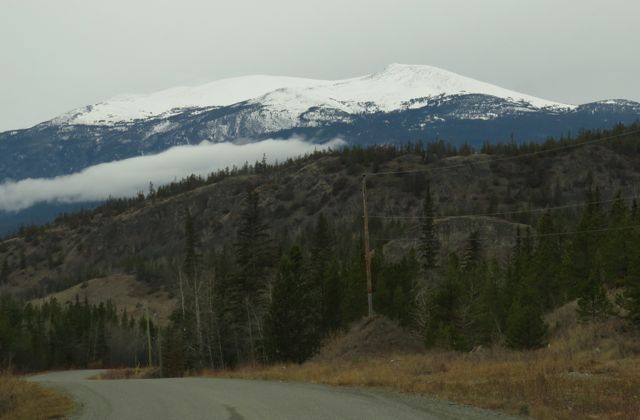

Glad you made it home in one piece. Good luck again with your vehicle. Send me a email when your settled and can get those 2 signed books off to me.
Regards, R. Gary Stollenwerk
So glad to know you are safely home! Now – – on to the work of getting ready for winter……..Bet Ginty Creek had a little dusting of snow while you were gone!
busy as ever.
and here I thought the long period between posts was due to the exhausting schedule.
what was I thinking?
thanks for taking us along
Barbara recently posted…Slow and Steady